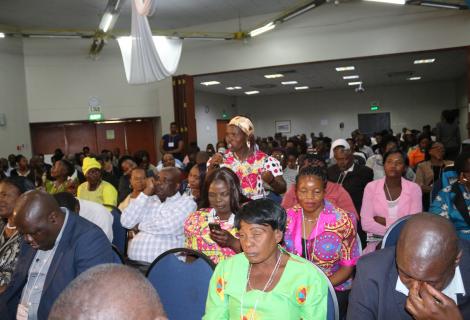Zimbabwe Alternative Mining Indaba 2019

Leaving No One Behind!
By Andrew Karamaji, Youth Advisor, ActionAid Zimbabwe
Replete with an array of spectacular cultural and Afro Pop performances that highlighted the plights and hopes of mining communities, the annual Zimbabwe Alternative Mining Indaba (ZAMI) begun in earnest on 18 September 2019 in the famed City of Kings, Bulawayo.
The three-day gathering drew participants from the fraternity of nongovernmental organisations, holders of elective and appointive public offices, communities that eke out a living from mining, development partners and scholars. Being the 8th Edition of the ZAMI, the conference has maintained its role of giving a voice to the voiceless.
“ZAMI has been a platform that has enabled us to demand for our rights in particular learning on how to engage members of Parliament who also attend the conference. Through ZAMI, we are lobbying for policies on compensation in Zimbabwe and mineral law reforms so that we recover from the effects of mining taking place in our areas,” said Gladys Mavhusa from Chiadzwa, a diamond mining area in Manicaland Province and one of the women who attended the 2019 ZAMI.
ZAMI was organized by the Zimbabwe Environmental Law Association, Africa Forum and Network for Debt and Development, Zimbabwe Council of Churches and the Zimbabwe Coalition on Debt and Development, who are ActionAid Zimbabwe (AAZ) partners. In the musical and literal sense, Hugh Masekela’s legendary steam train continues to ply our countries in the South of the continent—not least in Zimbabwe.
Accordingly, on top of the agenda were matters pertaining to the rights of workers, concerns about the adverse effects of industrial scale mining on the environment, regulation of multinational concerns as well as protections for small scale miners.
The Indaba featured side sessions which were tailored along the café model. They were intended to shine a particular focus on emerging issues such as compensation of communities before expropriation of land, enforcement of the laws on mining and the responsibility to protect the quality of life of affected societies.
AAZ led the pack on the above topical areas. Particular attention was drawn to the phenomenon of Illicit Financial Flows which manifests heavily in this sector—in part because of its complexity and the porosity of existent institutions. Noteworthy was the attendance of citizens from neighbouring countries—their participation highlighted the similarities and contrasts between mining communities outside of Zimbabwe.
Also notable was the impressive grasp of issues by young people who showcased their debating skills and knowledge on the dicey question of tax holidays for multinationals. Doubtless there remains mineshafts of corrective efforts that need to be explored to improve the livelihoods of communities even though positive strides have been registered. This much was included in the successive declarations that were read by the communities and groups represented at the meeting.
Deep, deep, deep down in the belly of the Earth, When they are digging and drilling that mighty evasive stone, And when they hear that chio chio train, They always curse, curse the coal train.
As the hot September sun set on this annual get-together of like-minds, spirits were high as the steam train rolls towards achieving this year’s theme: “Building a legacy of citizen action for equitable and just natural resource governance in Zimbabwe.” Communities affected by mining from Risitu and Hotsprings in Chimanimani, Mutoko, Chiyadzwa (Mutare), Chivi, Shurugwi, Buhera and many others were all there to push for their rights. The train should leave no one behind.